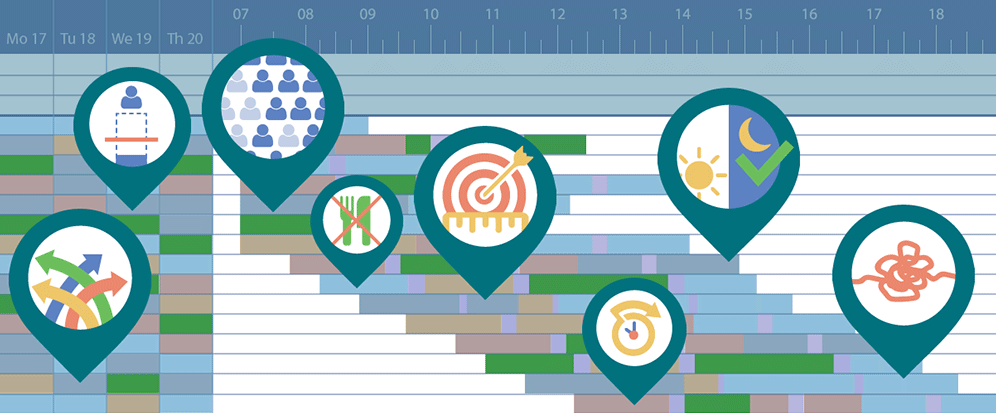Real-time management is perhaps one of the most crucial aspects of workforce management. This is where your employees are engaged with your customers, and the reputation of your business is directly impacted for the better or worse. Yet, it tends to get the least amount of attention when planning WFM strategy.
The business is very interested to know the forecasted headcount requirement because it impacts the number of people you need to hire and schedule. There is a lot of focus on ensuring that regression analysis and business intelligence produce a forecast that the business is willing to fund, balancing customer and shareholder need. The scheduling process also receives a lot of attention in planning, both for ensuring there are the right number of people to meet the customer accessibility targets and for employee well-being. Having bad schedules can hurt your customers and the employees who are entrusted to provide superior service to your customers.
>> Also interesting: Learn about smarter intraday management with Peopleware
So, why does real-time tend to be more ad-hoc? Well, it’s probably because it’s not really named right. When we say “real-time” what we’re really saying is “responding to the intraday variations to adjust the plan to reality”. So, this is really just the last step in the plan and not a separate activity. The forecasting and scheduling plans can be meticulous, but once you get to the day-of, you can face a number of variations that can impact your ability to deliver efficient service levels, including:
- High Call Volumes
- Long handle times
- System outages
- Poor schedule adherence
- Absenteeism
- Arrival patterns
- Ad hoc coaching / offline activities
The expectation of any workforce management team is that they’ve planned for these contingencies. The reality is that you can experience one or many of these at the same time. The pace is fast in contact centers and with a lot of moving parts, it’s easy to just throw more resources at the problem, or reskill agents to take other call types (perhaps delivering some ‘spirited’ feedback to the operations team?). Not only is this inefficient, but can cause a lot of employee dissatisfaction. The longer it takes to execute real-time management the longer the queues become and the more time and money it takes to recover the service level.
So what can you do to plan for adjusting to reality as it happens during the day?
1. Start with a clear plan of attack for the day, with contingencies outlined and agreed-upon
Best practice here is to have a simple one-page document that all team leaders and workforce management analysts have at their desks. This document should show the actions to take when service levels are above or below goal by a certain amount. For example, if service levels are 5 points below plan, non-critical offline activities are cancelled or rescheduled. Conversely, lay out what actions take place when service levels are above plan (remember, it’s not just about hitting service level, it’s about tightly aligning staff to the actual requirement). A good element of this plan is to outline when and how agents get reskilled from one call type to another. Getting this alignment right in advance makes the process smoother and more efficient.
2. Reforecast contact volumes and handle time at set points during the day
As you start to get information about what is actually happening during the day, this is your opportunity to draw some conclusions from what you’re seeing and project what you think will happen for the rest of the day based on this. Having done this reforecast, you will then want to take action on staffing accordingly. This allows you to adjust the 5pm staffing, for example at 1pm, instead of waiting until “real-time” to adjust. The biggest challenge in reforecasting is figuring out if what you’re experiencing is a temporary spike, or a trend. Engage the operations team, check call reason data and leverage any business intelligence you have to inform this. If you’re not sure, then it may be good to adjust the rest of the day by part of the variance and not all of it (e.g. if volume is up 15% by 11am, increase the rest of the day by 7% so you recognize the increase and take action, but lessen the risk of overstaffing.
3. Don’t manage schedule adherence real-time, manage it with reports
I know this will sound like fingernails on a blackboard to some people, but managing adherence in real-time takes up a lot of workforce management and leadership time and at best it just stops the bleeding. Part of schedule adherence is based on call length (e.g. 15-minute handle time calls will more likely drive someone out of adherence more than 3-minute handle time calls), and that should be factored into the projected adherence target. The larger issue is when schedules aren’t adhered to, which is behavior-driven. The best way to manage this is with historical reports, preferably the next-day. The employee can connect their behaviors during the day with the actual metric received. This best equips them to understand how they drive adherence. If you manage this real-time, it generally causes bad feelings and doesn’t address the core issue. On the other hand, if you manage this at the weekly or monthly level, then the adherence score is a meaningless metric, because the employee can’t tie together their behaviors with the outcome.
Try incorporating some of these ideas into your intraday actions. Not only will this help you to more effectively respond to the intraday variances, but it will improve the relationship between workforce management and operations! It’s a win/win.














